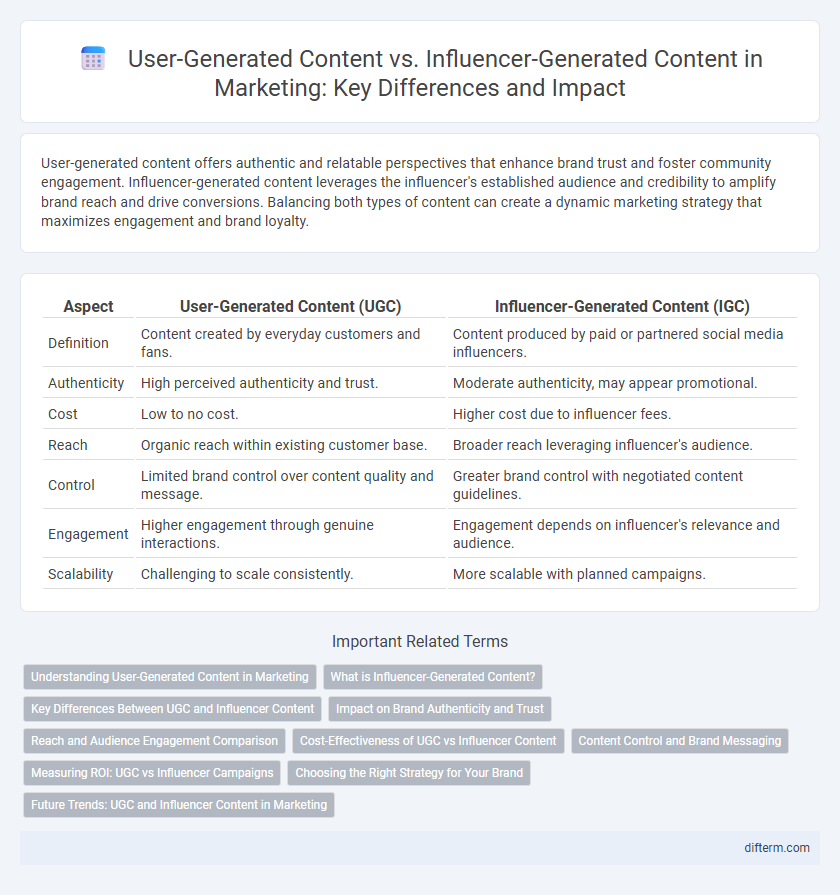User-generated content offers authentic and relatable perspectives that enhance brand trust and foster community engagement. Influencer-generated content leverages the influencer's established audience and credibility to amplify brand reach and drive conversions. Balancing both types of content can create a dynamic marketing strategy that maximizes engagement and brand loyalty.
Table of Comparison
| Aspect | User-Generated Content (UGC) | Influencer-Generated Content (IGC) |
|---|---|---|
| Definition | Content created by everyday customers and fans. | Content produced by paid or partnered social media influencers. |
| Authenticity | High perceived authenticity and trust. | Moderate authenticity, may appear promotional. |
| Cost | Low to no cost. | Higher cost due to influencer fees. |
| Reach | Organic reach within existing customer base. | Broader reach leveraging influencer's audience. |
| Control | Limited brand control over content quality and message. | Greater brand control with negotiated content guidelines. |
| Engagement | Higher engagement through genuine interactions. | Engagement depends on influencer's relevance and audience. |
| Scalability | Challenging to scale consistently. | More scalable with planned campaigns. |
Understanding User-Generated Content in Marketing
User-generated content (UGC) in marketing refers to authentic material such as reviews, photos, and videos created by consumers rather than brands, driving higher engagement and trust. UGC enhances brand credibility by showcasing real customer experiences, which can lead to increased conversion rates and organic reach across social platforms. Marketers leveraging UGC benefit from cost-effective content creation and stronger community building compared to influencer-generated content, which involves paid collaboration with influencers.
What is Influencer-Generated Content?
Influencer-generated content (IGC) refers to marketing materials created by individuals with a substantial online following who promote brands through authentic, relatable posts, videos, or stories. This type of content leverages the influencer's trust and authority within a niche to drive engagement and brand awareness more effectively than traditional advertising. Brands collaborate with influencers to produce tailored messages that resonate with targeted audiences, enhancing credibility and conversion rates.
Key Differences Between UGC and Influencer Content
User-generated content (UGC) is created by everyday consumers, reflecting authentic brand experiences, while influencer-generated content is produced by individuals with established credibility and large follower bases to strategically promote products. UGC often drives higher trust and engagement due to its organic nature, whereas influencer content leverages expert authority for targeted reach and brand positioning. Measuring effectiveness varies; UGC excels in building community and social proof, while influencer content focuses on brand awareness and conversion metrics.
Impact on Brand Authenticity and Trust
User-generated content (UGC) significantly enhances brand authenticity by showcasing genuine customer experiences and unbiased reviews, fostering a sense of trust and relatability among potential buyers. Influencer-generated content, while often polished and professionally crafted, leverages the influencer's credibility and niche audience to create perceived authenticity that can drive higher engagement and conversions. Brands balancing UGC and influencer content strategically amplify trust, combining authentic peer validation with targeted influencer endorsement to maximize impact on brand loyalty.
Reach and Audience Engagement Comparison
User-generated content (UGC) typically drives higher audience engagement due to its authenticity and relatability, often resulting in more comments, shares, and likes compared to influencer-generated content. Influencer-generated content excels in reach, leveraging the influencer's established follower base to quickly expose brands to a larger, targeted audience. Studies show UGC boosts trust and conversion rates, while influencer content is effective for scaling brand visibility rapidly.
Cost-Effectiveness of UGC vs Influencer Content
User-generated content (UGC) offers a cost-effective alternative to influencer-generated content by leveraging authentic customer experiences without high fees or sponsorship costs. Brands can maximize ROI with UGC by tapping into organic engagement and minimizing content production expenses linked to influencer partnerships. While influencer content may deliver targeted reach, UGC often drives higher conversion due to genuine peer recommendations and scalability at a fraction of the budget.
Content Control and Brand Messaging
User-generated content offers brands limited control over messaging but enhances authenticity and consumer trust by showcasing real customer experiences. Influencer-generated content provides greater control over brand messaging and consistency while leveraging the influencer's targeted audience and creative expertise. Balancing both strategies allows marketers to maximize reach and maintain a cohesive brand narrative across multiple channels.
Measuring ROI: UGC vs Influencer Campaigns
Measuring ROI for user-generated content (UGC) campaigns often reveals higher engagement rates and authentic brand interactions due to genuine consumer trust. Influencer-generated content typically delivers broader reach and targeted audience precision, but can involve higher costs and variable ROI depending on influencer credibility. Comparing ROI metrics such as conversion rates, cost per acquisition, and lifetime customer value helps marketers optimize budget allocation between UGC and influencer campaigns.
Choosing the Right Strategy for Your Brand
User-generated content (UGC) offers authentic engagement by leveraging real customer experiences, enhancing trust and community around your brand. Influencer-generated content delivers targeted reach and professional storytelling, driving brand awareness through trusted industry voices. Evaluating your brand's goals, audience preferences, and budget helps determine whether UGC's genuine perspectives or influencer content's polished promotion best aligns with your marketing strategy.
Future Trends: UGC and Influencer Content in Marketing
User-generated content (UGC) and influencer-generated content are evolving rapidly as central pillars in marketing strategies due to increasing consumer trust and engagement. Future trends show a convergence where brands leverage authentic UGC alongside influencer campaigns to create hybrid content that amplifies reach and credibility. Advanced AI tools and data analytics will enable more precise targeting and personalization, enhancing the effectiveness of both content types in driving conversions.
User-generated content vs influencer-generated content Infographic

 difterm.com
difterm.com